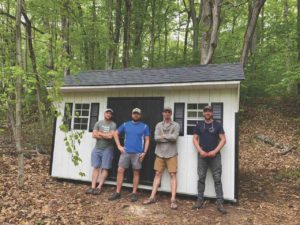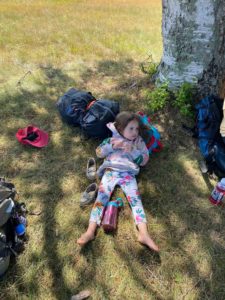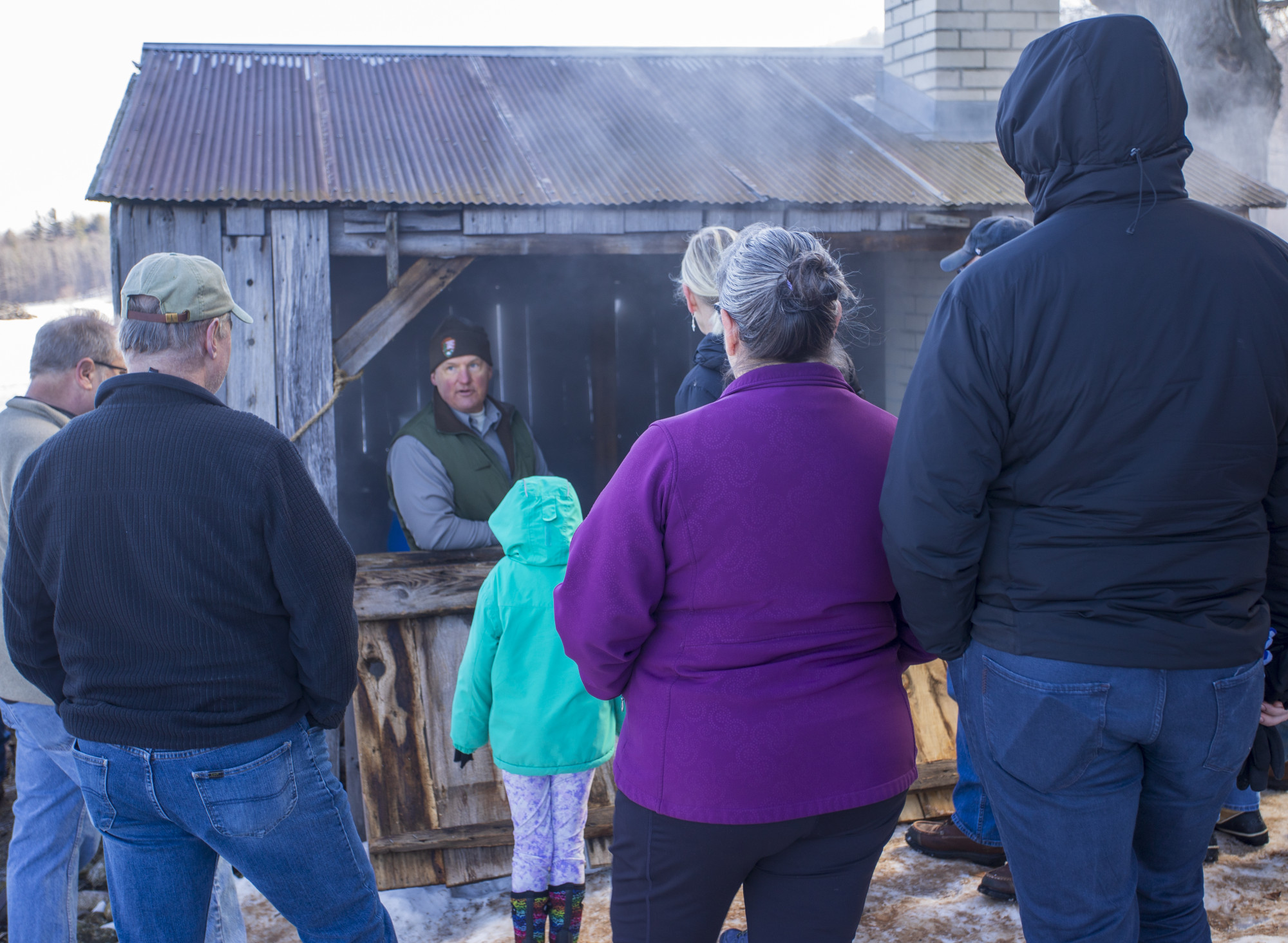Leland Public School embraces North Manitou school project
By Abby Chatfield
Sun contributor
With the opening of the Erie Canal in 1825, the channel between the Manitou Islands and the mainland became a sheltered and popular shipping route known as the Manitou Passage. European settlers moved to the Manitou Islands not long after as they sought opportunities in logging, fueling the steamships moving cargo and passengers around the Great Lakes.
After the forests were harvested, island residents turned to farming and continued to live on North Manitou Island for years to come, many staying year-round while others occupied it as a seasonal resort to escape the stifling heat of summer in cities like Chicago. By the turn of the 20th century, the population was ample enough to require the various services of thriving societies such as a post office, general store, and a school.
The first school was made of logs in 1895 and held 36 students. A new school was built in 1907 with a wood frame and front porch but was shut down in the 1940s as the island’s permanent population dwindled. Decades later, when Leland Public School (LPS) discovered they owned this one-acre property, considered the home of Leland School District’s first school, all that still existed was the decaying framework of a one-room schoolhouse.
The story goes that the LPS Board became aware of the North Manitou Island school property in the late 1980s or early ’90s. The decision was made to tear down the remnants of the historical yet dilapidated schoolhouse, but the consensus was that the property was too remote and isolated to take students.
Fast forward more than 25 years. Nick Seguin, a first and second grade teacher for Leland since 2009 who graduated from Michigan State University with a degree in Natural Resources, spends his summers working as a guide for Manitou Island Transit. While hiking on North Manitou Island, Seguin came across the old school site, recognizing it by a crumbling foundation. Intrigued, he began to study plat maps and rediscovered the property deed, realizing that the land still belonged to the Leland School District.
In the early 1900s, the district encompassed North Manitou Island. After the establishment of the Sleeping Bear Dunes National Lakeshore in 1970, the federal government began transferring private property to public land by right of eminent domain. The park was created almost entirely from private property, creating much controversy at the time as thousands of individual tracts of land were purchased, many with the government’s power of eminent domain under reasoning that the land was better off in public hands in the long-term.
However, the federal government did not use eminent domain to acquire the one-acre parcel owned by Leland School District on North Manitou Island due to the legal difficulties of transferring property between governmental entities, as school districts are also considered an entity with the ability to practice eminent domain. Following his rediscovery through plat map research, Seguin spent most of 2015 convincing LPS superintendent Jason Stowe to turn the school’s focus back to the property, thus initiating the North Manitou School Project. A mission to build back and utilize the island property for school purposes was set into motion.
Seguin said that Leland’s current superintendent, Stephanie Long, is also passionate about and supportive of both the project and outdoor education in general. As LPS sings a different tune from 25 years ago, the property is now thought to be an ideal location for school visits. A half-mile south of the National Park Service’s dock between Cottage Row and a cherry orchard, it is just a 10-minute walk to the village for emergencies and amenities such as running water and restrooms. It is also very close to the high road, making it convenient to jump onto the island’s main trail system.
It was 2019 when physical work to restore the island property kicked off. That summer, Seguin built a large, permanent fire ring on the site, complete with a fire grate and locking lid. In 2020, his project was installing a flagpole. By the following year, LPS Board Member Logan Suttman joined forces with Seguin to build a wooden stand on site for a historic bell that many, who are familiar with Leland School in the village of Leland, would recognize. Originally located on the island, the bell spent decades adorning the exterior of the mainland school before the two men moved it back to its rightful home on North Manitou.
This summer, volunteer power doubled to four able-bodied and determined men – three of them fathers to LPS students – and work efforts ramped up. Seguin and Suttman, with help from Bill Duperon and Chris Haines, installed an 8’ x 14’ wooden outbuilding on the island property to house emergency materials, work equipment, chairs, tables, and basic camping supplies.
Manitou Island Transit ferry service delivered the pre-built walls and floor, made by Jim’s Amish Structures, to the island. Then the volunteer team, who named themselves the “Half as Fast, Twice as Hungry Construction Company,” hauled the pieces from the beach and carried in all necessary supplies to finish construction. They leveled the ground, lay the flooring, erected the sides, and built the roof on site, while somehow still finding plenty of time for swimming and cooking elaborate meals over a roaring campfire.
In the initial years of the project, Superintendent Stowe started a fund for the project. Most of the money was used to pay for the shed materials. Otherwise, all labor and time has been donated by volunteers.
Duperon visited the site three times this summer, with a fourth trip scheduled in September to give a tour to the Leelanau Historical Society. The volunteer work allowed Duperon to bring his wife, Bailey, and their two young daughters out for a camping trip on the property. Duperon observed that his daughters “felt the same sense of freedom we did, just in a different way.” Their eldest daughter, Zoey, is nine years old and going into fourth grade. She’s joined her father twice now, while almost four-year old Ramie just completed her first-ever camping trip.
Now that the site is generally set up for group use, a couple of Leland’s sports teams have also visited. Coach Karen Kirt took her cross-country team out, and Suttman accompanied one of Leland’s soccer teams for a team-building experience.
There is plenty of work yet to come. Other than a compostable toilet and possibly a well, the North Manitou School Project plan includes building a bunkhouse on site. Seguin envisions the structure to look just like the old schoolhouse on the exterior, but the inside will include a bunk area and large gathering space. A handful of donors returned four of the desks from the old island schoolhouse, and there are plans to gather other original materials as well.
However, to use sizeable equipment, the group will need a Wilderness Exemption from the national park. Pier and beam structure is instead a possibility, as digging and pouring foot holes requires less machinery. “The national park service has been very supportive, especially deputy superintendent Tom Ulrich,” shared Seguin.
They also need guidance and approval from Leelanau County. The next steps are to render plans for building the structure and taking them to the county to find out building codes and other requirements. Following that comes finding resources and assessing the need for volunteer help. “There’s a lot of passion behind the project,” expressed Duperon.
Both Seguin and Duperon see a need for more helping hands when the time is right. Once plans are finalized and the project enters the main construction phase, an army of volunteers may be in need to transport materials both off and on land, help with building, fundraising, and program planning, among other things yet to be determined.
Preliminary fundraising plans are in the works, but the finalized plan for the bunkhouse must first be in place before Seguin feels comfortable soliciting donations. “I’d love to see this come into fruition before Zoey graduates,” Duperon said. “It will create an opportunity for kids that’s very unique. What other school has an island?”
One possibility Seguin is excited about is using this as an opportunity to help other school districts find forgotten property on federal lands. According to Seguin, many districts own property on federal land that they are not yet aware of, and this could be a way to help them discover what they have by sharing the process that LPS is going through.
Duperon hopes to see kids from inner city schools and other places where the outdoors is not as easily accessible get to experience North Manitou Island through the school project, while Seguin hopes to see the property as self-sustaining in the long term, paying for itself through tuition-based summer programs.
Once the main structure is in place, outdoor education and programming can begin to take place. LPS may utilize the site for student outings throughout the short fall and spring windows when the island is safely reachable via Manitou Island Transit’s ferry service. Seguin envisions every grade level and academic subject touching ground on the island during the school year with tuition-based programming taking place throughout the summer season. Who would operate summer programming is yet to be determined, but it is possible that either Leland Public School could take charge year-round or partner with other groups.
Although LPS does not mind curious visitors passing by their property on the island, they do not permit camping by the public for liability purposes. When visiting North Manitou Island, please remember to respect private property along with the national lakeshore’s history and wildlife.













